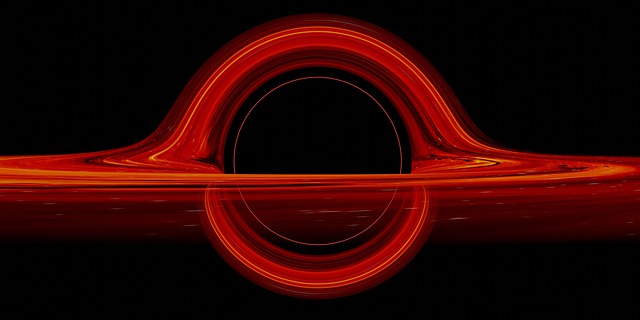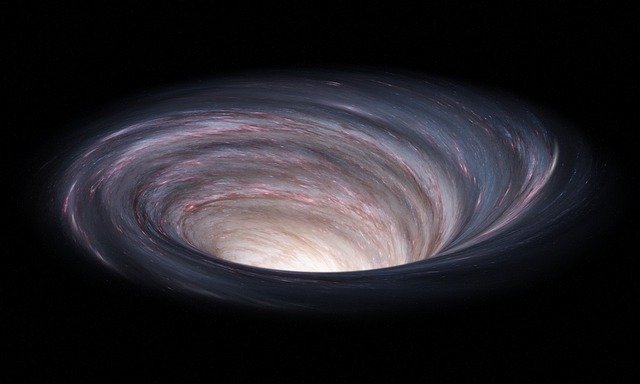*This post may contain affiliate links. This means we may make a commission if you purchase an item using one of our links*
The main difference between a black hole and a wormhole is where they physically end. Black holes come to a point of extreme density called a singularity from which nothing can escape – not even wavelengths of light. A wormhole has two open ends which hypothetically connect two different points in time and space.
If the two ever collided, the black hole would oscillate between the openings of the wormhole, eventually getting stuck in the middle.
In this article, we’ll describe what constitutes a black hole versus a wormhole, the differences between the two celestial bodies, and provide theoretical detail regarding their potential interaction. Prepare to be sucked in as we tackle space’s most elusive and intriguing phenomena.
What Is a Black Hole?
Table of Contents

A black hole is created when a large star collapses in on itself during a supernova explosion. The density of the star creates a massive gravitational pocket and pulls everything within its vicinity into it.
The edge of a black hole is known as the event horizon and once something crosses this point, there is no escape. The gravitational pull of a black hole is so immense that even light is sucked inside. All objects pulled in are subjected to an unimaginable crushing gravitational force as they are pulled toward the super dense end point of the black hole known as the singularity.
What Are the Different Types of Black Holes?
There are three different types of black holes: supermassive black hole, intermediate mass black hole, and stellar mass black hole.
Stellar mass black holes are formed as described above by the death of a large star collapsing inward on itself. An intermediate mass black hole is slightly larger than a stellar mass black hole and may form be acquiring stars within its reach although not many have been discovered so little is still known about them.
A supermassive black hole can be found at the center of a galaxy and consumes stars and smaller black holes in order to obtain its massive size – millions of times larger than our Sun.
What Is a Wormhole?

A wormhole is a theoretical celestial body through which two separate points in space and time are connected. According to Einstein’s theory of relativity, a wormhole is possible although none have actually been confirmed to exist in our universe.
There are a few theories as to how a wormhole may form. Some believe that wormholes are born from the entanglement of two black holes. Hypothetically if the singularities of two black holes are joined to form a tunnel, then it’s possible to create a wormhole with the separate event horizons existing in different points of time and space.
Others speculate that the collision of a black hole, where nothing can escape, and a white hole, where nothing can enter, may be able to create a wormhole. Whether wormholes exist outside the theoretical realm remains to be seen.
What Are the Different Types of Wormholes?
There are two types of wormholes speculated to exist: Lorentzian and Euclidean. Lorentzian wormholes are the classic portals between two different points in time and space. Euclidean wormholes are a bit more complicated, obeying the laws of quantum mechanics and dealing with particle physics more than spacetime dimensions.
What Are the Differences Between a Black Hole and a Wormhole?
The most significant difference between a black hole and a wormhole is the final destination of the objects drawn inside each. They also differ in their gravitational ability and potential radiation emissions.
Within a black hole, all objects end up at one point known as the singularity from which they can hypothetically never be released. On the other hand, an object that enters a wormhole travels as if through a tunnel and is released through the other end in a different point in time and space.
In terms of gravitational pull, nothing can escape a black hole once it crosses the event horizon. However, according to the theoretical model of a wormhole, the comparable point to a black hole’s event horizon would have to be more forgiving considering objects would be coming out of as well as going into the wormhole at that point.
There is a new theory that proposes a potential way to determine the difference between a black hole and a wormhole simply by measuring the emissions of gamma radiation. In theory, gamma rays should be emitted in a single jet-stream fashion from a black hole, while the gamma radiation of a wormhole would appear as a giant sphere.
What Would Happen If They Were to Interact?
If a black hole collided with a wormhole bigger than itself, the black hole would be trapped in a back-and-forth journey between the two openings of the wormhole before getting stuck in the center of the tunnel.
If a large black hole collided with a smaller wormhole, the black hole would consume the wormhole and the massive energies acquired would most likely result in the creation of a larger black hole.
The collision of a black hole and a wormhole resulting in the black hole getting stuck in the wormhole’s center could provide a way to detect wormholes. The gravitational signal given off by the black hole stuck forever minutely oscillating in the middle of the wormhole’s tunnel may be unique enough for scientists to prove the existence of a wormhole.
Summary
Black holes and wormholes are two of space’s most peculiar and unique phenomena – one of which we know definitively exists, the other still pure speculation. An object which travels into a black hole enters across the event horizon and eventually becomes pulled into the singularity due to the massive amount of gravitational force.
An object which enters a wormhole, on the other hand, travels through a tunnel made in space and time and exits the other side in a wholly different place. In the event that these two massive beings collided, a black hole invariably be stuck within a wormhole indefinitely or the wormhole could collapse and form a brand-new black hole.
References
https://www.space.com/black-holes-fall-into-wormholes-gravitational-waves.html
https://astronomy.com/news/2020/07/what-would-happen-if-you-fell-into-a-black-hole


This is probably a dumb question, but here goes:
Is it possible a black hole, and a worm hole, could somehow combine and lead to another universe? Would that be a method by which one universe could become aware of another universe? Has there been any speculation in that area, or is it just a silly question? Assuming my thought is ridiculous, is there a current hypothesis about how we, in our universe, could become aware of a separate universe?
No, that isn’t a silly question, but it’s also not a question that I’ve really looked into before. Therefore, my team and I will eventually look into and see if modern literature has anything to say of a black hole and wormhole potentially connecting to other universes.
For me im not an expert but blackholes cannot merge with wormholes.
Ok they can.